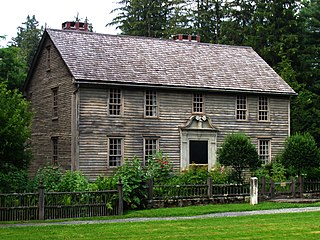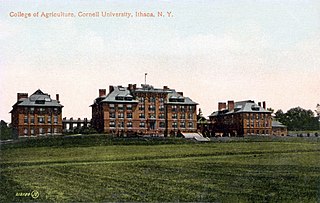
Ithaca is a city and the county seat of Tompkins County, New York, United States. Situated on the southern shore of Cayuga Lake in the Finger Lakes region of New York, Ithaca is the largest community in the Ithaca metropolitan statistical area. It is named after the Greek island of Ithaca.

Ithaca College is a private college in Ithaca, New York. It was founded by William Egbert in 1892 as a conservatory of music and is set against the backdrop of the city of Ithaca, outside Cayuga Lake, waterfalls, and gorges.

The Cornell Botanic Gardens is a botanical garden located adjacent to the Cornell University campus in Ithaca, New York. The Botanic Gardens proper consist of 25 acres (10 ha) of botanical gardens and 150 acres (61 ha) of the F. R. Newman Arboretum. The greater Botanic Gardens includes 40 different nature areas around Cornell and Ithaca, covering 4,300 acres (1,700 ha).

The Clinton House is a historic building located in downtown Ithaca, New York. It is built primarily in the Greek Revival style, common in older buildings in Ithaca. It currently houses offices and a local charter school. It is directly adjacent to the Ithaca Commons.

The Boardman House, also known as the Scotch-Boardman House or the Bennett-Boardman House, is a historic house located at 17 Howard Street, Saugus, Massachusetts. Built in 1692, it was designated a National Historic Landmark in 1961 because of the remarkable amount of original building material still present in the house. It has been owned by Historic New England since 1914, and is open to the public on select weekends between June and October.

The Mission House is an historic house located at 19 Main Street, Stockbridge, Massachusetts. It was built between 1741 and 1742 by a Christian missionary to the local Mahicans. It is a National Historic Landmark, designated in 1968 as a rare surviving example of a colonial mission house. It is now owned and operated as a nonprofit museum by the Trustees of Reservations.

Llenroc is a Gothic revival villa built for Ezra Cornell, the founder of Cornell University. It is located at 100 Cornell Avenue in Ithaca, New York, United States, just below the Cornell University campus. Since 1911, it has been the home of the Pi Chapter of the Delta Phi fraternity. The house was added to the National Register of Historic Places in 1980.

Justin Morrill Hall, known almost exclusively as Morrill Hall, is an academic building of Cornell University on its Ithaca, New York campus. As of 2009 it houses the Departments of Romance Studies, Russian Literature, and Linguistics. The building is named in honor of Justin Smith Morrill, who as Senator from Vermont was the primary proponent of the Morrill Land-Grant Colleges Act of 1862 which greatly assisted the founding of Cornell University. Morrill Hall was declared a National Historic Landmark in 1965.

Deke House, the Delta Kappa Epsilon or "Deke" House on the campus of Cornell University, was built in 1893 and was listed on the National Register of Historic Places in 1991. It was designed by William Henry Miller to serve as a fraternity house. Two trees which Theodore Roosevelt planted in front of the house are on the National Register of Historic Trees.

Roberts Hall was the first building of the New York State College of Agriculture at Cornell University, built 1905–1906, and demolished July 1990. A second building of that name was built in 1990.

East Roberts Hall was a building on the campus of Cornell University in Ithaca, New York, which opened on Wednesday, October 10, 1906. Originally just referred to as the Dairy Building, it was not called East Roberts Hall until 1923 when other departments moved in and the Dairy Department moved out and into the new Dairy Building. East Roberts Hall was demolished along with Roberts and Stone Halls ca 1987-1988.
The National Register of Historic Places listings in Syracuse, New York are described below. There are 116 listed properties and districts in the city of Syracuse, including 19 business or public buildings, 13 historic districts, 6 churches, four school or university buildings, three parks, six apartment buildings, and 43 houses. Twenty-nine of the listed houses were designed by architect Ward Wellington Ward; 25 of these were listed as a group in 1996.

St. James AME Zion Church is a historic African Methodist Episcopal Zion church located at Ithaca in Tompkins County, New York. It is a two-story, frame church structure set on a high foundation and featuring a four-story entrance tower. The church structure was begun in the 1830s and modified many times since. The original stone meetinghouse was built in 1836 and is believed to be Ithaca's oldest church and one of the oldest in the AME Zion system.

State Theatre of Ithaca is a historic, 1600-seat theatre located at Ithaca in Tompkins County, New York that hosts various events from bands, to plays, to comedy acts, to silent films, and more.

De Witt Park Historic District is a national historic district located at Ithaca in Tompkins County, New York. The district consists of 45 contributing buildings, one contributing site, and three contributing objects. It includes the area developed by the town's founder, Simon De Witt, in the early 19th century. The district includes the separately listed Boardman House and Second Tompkins County Courthouse.

Cornell Heights Historic District is a national historic district located in Ithaca, New York. The district contains 208 contributing buildings and one contributing site. It consists of an early 20th-century residential subdivision developed between 1898 and 1942, and originally conceived as a "residence park" for faculty members of Cornell University, directly north of the Fall Creek gorge.

Central Campus is the primary academic and administrative section of Cornell University's Ithaca, New York campus. It is bounded by Libe Slope on the west, Fall Creek on the north, and Cascadilla Creek on the South.

The Boardman–Mitchell House is a three-story, six-bedroom Italianate villa located at 710 Bay Street, Staten Island, New York. It also has the address of 33 Brownell Street since it connects to both streets. It is a New York City Landmark and was listed on the National Register of Historic Places in 2012. It is known as a good example of a suburban architectural style used in an urban setting, as well as its connection to the piloting history of that portion of Staten Island.

The Telluride House, formally the Cornell Branch of the Telluride Association (CBTA), and commonly referred to as just "Telluride", is a highly selective residential community of Cornell University students and faculty. Founded in 1910 by American industrialist L. L. Nunn, the house grants room and board scholarships to a number of undergraduate and graduate students, post-doctoral researchers and faculty members affiliated with the university's various colleges and programs. A fully residential intellectual society, the Telluride House takes as its pillars democratic self-governance, communal living and intellectual inquiry. Students granted the house's scholarship are known as Telluride Scholars.
Douglass Boardman was an American jurist and lawyer who served on the Supreme Court of New York and as Dean of Cornell Law School.






















